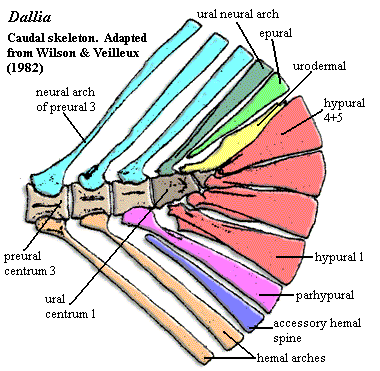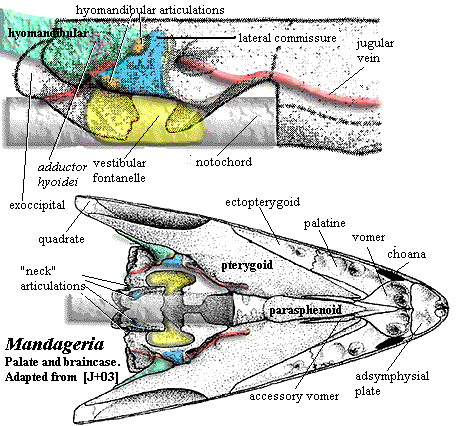| Glossary | ||
| The Vertebrates | U-V |
| Vertebrates Home | Vertebrate | Vertebrate | Bones | Time |
For most phrases beginning with directional words, e.g. "posterior," "dorsal," "external," etc., or some generic anatomical terms, e.g., "vena," look under the next word in the phrase. However, note that this convention is not used with complete consistency in this Glossary.
Ulan Gochu Formation Early Oligocene of China (Inner Mongolia).
Ulnareone of the proximal carpal bones of the wrist. See figure at carpus.

Unciform [1] in mammalian osteology, one of the distal tarsals, normally articulating with metacarpals IV & V and with the cuneiform. [2] anything hook-like (same as hamate).
Uncinate bearing a tab-like process at right angles to the main shaft; particularly of ribs, bearing a posteriorly-directed uncinate process which overlaps with the next more posterior rib (common in early tetrapods, birds and some other groups) to assist in respiration, in bracing the scapula, or to stiffen the body wall against lateral pressures for protection of the gut or in locomotion.
Uncinate process A roughly triangular posterior process on the dorsal ribs of birds which overlaps the shaft of the next most posterior rib. In birds, uncinate processes are thought to be involved (a) stiffening the body to improve flight efficiency and (b) providing muscle attachment sites which move the ribs as a part of the avian respiratory cycle. Uncinate processes were also developed in Colosteids and other basal tetrapods.
Unfinished bone bone lacking a smooth periosteal surface. The usual implication is that the bone was still growing, was covered in cartilage, or both.
Ungual the terminal phalanx of a digit which bears a claw, hoof or other keratinous terminal extension of the phalanges.
Unguiligrade locomotion in which the main weight-bearing surface is the unguals -- typical of (surprise!) ungulates.
Uniserial "In one row or series; arranged in a single row" FishBase Glossary Searched Term. As applied to fins, having the bone elements extended along a single axis.
Uquian Age South American Land Mammal Age corresponding to the Late Pliocene and Early Pleistocene.
Uro-, Ura- Gr. = tail.
Ural [1] in geography, relating to the Ural Mountains in western Russia; [2] in anatomy, relating to the tail; [3] in fish anatomy, the more posterior tail region, in which the hemal arches bear flat hypurals, rather than hemal arches enclosing the caudal artery.

Urodermal in fishes, paired, thin dermal bones at the rear of the caudal fin skeleton, derived from scales.
Uroneural in fish tail anatomy, obsolete term for urodermal? But Johnson & Patterson (1997) treat them as two different bones. In their view, the esociform bone, illustrated here, is a uroneural.
Uropatagium Skin membrane extending between the hind legs and frequently enclosing the tail - especially in bats or pterosaurs.
Urostyle [1] the small upturned posterior tip of the vertebral column, generally formed of fused vertebrae and associated elements (in homocercal caudal fins of Teleostomi), [2] the fan-like series of bones articulating with the last true vertebra, including preural centra, ural centra, epurals and hypurals. Counted as one vertebra in some vertebral counts, not counted in others.
Usu (abbr.) usually; used here as a signal that the described character is not a synapomorphy, although it may be common within the clade.
Utriculus One of the maculae, vaguely sac-like areas of the vestibular apparatus in the inner ear involved in the perception of linear acceleration, orientation in a gravity field, and low-frequency or high-volume sounds. See The Ear.
Uzunçarsidere Formation Late Cretaceous (Early Paleocene?) to Middle Eocene (Lutetian) of Central Anatolia, Turkey -- very close to Ankara. Part of the Haymana Basin. Red clastics. Mammals. Sometimes referred to as part of the Kartal Formation.
Vacuity opening or perforation in a bony plate
Vagus nerve the Xth (tenth) cranial nerve. Both motor and sensory functions. Innervates among other organs) the heart and anterior digestive tract, as well as gill arches 4-7 and the lateral line system.
Vagus foramen the reptile analogue of the jugular foramen. It is located near the base of the paroccipital process, between the exoccipitals and the opisthotic, and contains one or more foramina for cranial nerves IX, X and/or XI, and who knows what else. The vagus foramen is created by walling off part of the metotic foramen into a specialized exit for various cranial nerves. The remaining part of the metotic fissure is may then be referred to as the fenestra pseudorotunda since it can specialize to perform the same function as the fenestra rotunda.
Valanginian an age of the Early Cretaceous, about 137-132 Mya. See Valanginian
Vasodentine dentine penetrated by blood vessels.
Veluma respiratory pump found in basal craniates.
Ventral Fissure a transverse gap, fissure, crack, fossa, or what-have-you in ventral surface of the braincase separating the sphenoid and otic regions.
Verrucosic after Sus verrrucosus, one of two morphotypes of the canine found in suoids. In verrucosic canines, the tooth is approximates a scalene triangle in cross-section. The lingual face is broadest, and the labial (inner) face is second broadest. As opposed to scrofic.
Vert(abbr.) vertebra.
Vestibula an enclosed space
Vestibular apparatus The functional apparatus of the inner ear. See The Ear.

Vestibular fontanelle a large basicranial fenestra below the notochord in some sarcopterygians and very basal tetrapods. The vestibular fontanelle opens into the saccular region of the inner ear.
Vestibulocochlear nerve same as auditory or VIIIth cranial nerve.
Vibrissa in mammals, a "whisker," i.e., a stout, stiff and generally very long, tactile bristle growing singly or in small clusters, mostly in a few constant sites on the body
Vidian Canal a/k/a Pterygoid canal. Palatine ramus of the VIIth (facial) nerve (humans) and/or internal carotid artery (mosasaurs). In mammals it also carries elements of the petrosal nerve. PPT Slide; Discussion. Structurally, I'm not sure what it is or how to define it ... Sorry.
Viliform thin, elongate, needle-like.
Villus (pl. "villi") Latin for (shaggy) hair hence O. Fr. villein, at a guess?). A hair-like projection, normally used in describing microvilli, hair-like projections from a cell wall which are not motile. They normally function as sensory organelles or to increase surface area for absorption.
Vinculum In birds, a tendon which emerges from the distal end of the humerus and follows the posterior margin of the wing, attaching at the distal end of digit 2. The raches of the remiges (i.e., the stems of the flight feathers) are stabilized by passing through the vinculum.
Visceral medial or axial. Normally used of surface anatomical structures to describe the side toward the center or axis of the body.
Volant flying, capable of flight.
Volarimagine a man standing with arms at the sides, palms facing toward you - that is the volar surface of the arm. directions on the body. Apparently synonymous with palmar or plantar.
Volkmann's Canals see Osteon.
Vomer A median paired or unpaired bone lying in the floor of the nasal cavity (above the hard palate in mammals).
Vomeronasal OrganJacobson's Organ; a chemosensory organ located in the roof of the mouth.
checked ATW050828